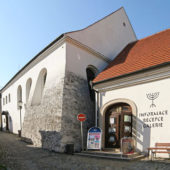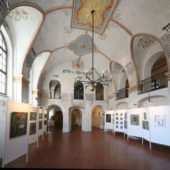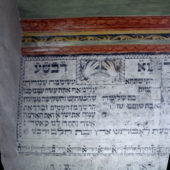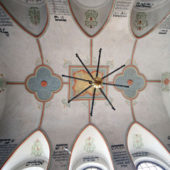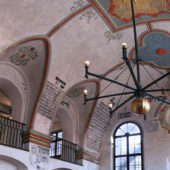The massive stone exterior hides the baroque painted interior.
Wedged into the heart of the old Jewish Quarter of Trebic in Moravia, the New Synagogue (also known as the “Back” or “Rear” Synagogue) is traditionally dated to 1737. However, the building layout along with the stone entrance and vaulted ceiling suggest a late Renaissance origin dating back to perhaps as early as the turn of the 15th and 16th centuries. Some have dated it a bit later to 1667. Regardless, an earlier dating would have corresponded to a significant growth in Trebic’s Jewish population which local experts say occurred during the 17th century.
The Rear Synagogue was one of the centers of worship for Trebic’s Jews for the next several centuries, undergoing an expansion on the north side in 1837 when a women’s gallery was added. Trebic’s Jews reached their peak population in the mid 18th century, accounting for nearly 60 percent of the town’s population, though they were confined to the quarter, called the Zamosti (meaning “behind the bridge”).
The synagogue interior features a barrel vaulted ceiling decorated with baroque stucco and walls painted with Hebrew scripture and dedications to generous members of the community who helped support the synagogue’s upkeep. The writings are accented by colorful floral frescoes and gold painted scrollwork. The nave itself is lit through five lattice windows with semicircular apexes. The women’s gallery has barrel vaulting with lunettes and opens out into the main nave through three archways.
In 1848, new laws liberated Jews from their confinement to small-town ghettos and many of Trebic’s Jews moved to larger cities such as Brno and Prague. Still, a thriving Jewish community remained and the synagogue was used up to World War I when it was bought and turned into a storage facility. In WWII, the Germans rounded up 280 Trebic Jews and shipped them off to concentration camps. Only 10 survived, not enough to revive their hometown’s community much less keep a synagogue going. At the end of the main hall in the synagogue is a list of those Trebic Jews who perished in the Holocaust.
During the Communist era, the Rear Synagogue continued as a storage building for potatoes and vegetables before being abandoned and falling into disrepair. After the collapse of communism in Czechoslovakia, a renewed effort to preserve Trebic’s history sprung to life and the Rear Synagogue, under the guidance of architect Harald Cadílek, has since undergone major restoration, reopening in 1997. Today, it is used for chamber music concerts, meetings and exhibitions. The Zamosti, including the Rear Synagogue was named a World Heritage Site by UNESCO in 2003, for the exemplary state of its Jewish Quarter – the only Jewish Heritage site so named outside of Israel, so far.

